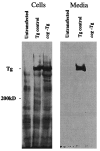A single amino acid change in the acetylcholinesterase-like domain of thyroglobulin causes congenital goiter with hypothyroidism in the cog/cog mouse: a model of human endoplasmic reticulum storage diseases
- PMID: 9707574
- PMCID: PMC21435
- DOI: 10.1073/pnas.95.17.9909
A single amino acid change in the acetylcholinesterase-like domain of thyroglobulin causes congenital goiter with hypothyroidism in the cog/cog mouse: a model of human endoplasmic reticulum storage diseases
Abstract
Newly synthesized thyroglobulin (Tg), the major secretory glycoprotein of the thyroid gland, folds and homodimerizes in the endoplasmic reticulum (ER) before its export to the site of iodination, where it serves as the precursor for thyroid hormone synthesis. In families with defective Tg export, affected individuals suffer from a thyroidal ER storage disease characterized by a distended thyrocyte ER containing misfolded Tg, along with induced ER molecular chaperones. Inherited as an autosomal recessive trait, deficient Tg causes congenital hypothyroidism in newborns that, if untreated, results in goiter along with serious cognitive and growth defects. Recently, a similar phenotype has been observed in inbred cog/cog mice, although the precise molecular defect has remained undefined. Here, we have isolated and cloned a full-length 8.5-kb Tg cDNA from cog/cog mice and unaffected isogenic AKR/J mice. Comparison of the complete sequences reveals that cog/cog mice express a Leu-2263 --> Pro missense mutation in the acetylcholinesterase-homology domain of Tg. Heterologous expression studies in COS cells indicate that cog Tg exhibits a severe defect in exit from the ER. Site-directed mutagenesis of cog Tg to convert the single amino acid back to Leu-2263 restores normal Tg secretion. We conclude that the cog mutation in Tg is responsible for this ER storage disease that causes thyroid dyshormonogenesis.
Figures





Similar articles
-
An endoplasmic reticulum storage disease causing congenital goiter with hypothyroidism.J Cell Biol. 1996 May;133(3):517-27. doi: 10.1083/jcb.133.3.517. J Cell Biol. 1996. PMID: 8636228 Free PMC article.
-
Maintaining the thyroid gland in mutant thyroglobulin-induced hypothyroidism requires thyroid cell proliferation that must continue in adulthood.J Biol Chem. 2022 Jul;298(7):102066. doi: 10.1016/j.jbc.2022.102066. Epub 2022 May 23. J Biol Chem. 2022. PMID: 35618019 Free PMC article.
-
Unfolded protein response is involved in the pathology of human congenital hypothyroid goiter and rat non-goitrous congenital hypothyroidism.J Mol Endocrinol. 2004 Jun;32(3):903-20. doi: 10.1677/jme.0.0320903. J Mol Endocrinol. 2004. PMID: 15171721
-
Defective thyroglobulin synthesis and secretion causing goiter and hypothyroidism.Endocr Rev. 1993 Apr;14(2):165-83. doi: 10.1210/edrv-14-2-165. Endocr Rev. 1993. PMID: 8325250 Review.
-
Genetics and phenomics of hypothyroidism and goiter due to thyroglobulin mutations.Mol Cell Endocrinol. 2010 Jun 30;322(1-2):44-55. doi: 10.1016/j.mce.2010.01.009. Epub 2010 Jan 20. Mol Cell Endocrinol. 2010. PMID: 20093166 Review.
Cited by
-
Thyroglobulin From Molecular and Cellular Biology to Clinical Endocrinology.Endocr Rev. 2016 Feb;37(1):2-36. doi: 10.1210/er.2015-1090. Epub 2015 Nov 23. Endocr Rev. 2016. PMID: 26595189 Free PMC article. Review.
-
Dominant protein interactions that influence the pathogenesis of conformational diseases.J Clin Invest. 2013 Jul;123(7):3124-34. doi: 10.1172/JCI67260. Epub 2013 Jun 3. J Clin Invest. 2013. PMID: 23722904 Free PMC article.
-
Conserved cysteine residues provide a protein-protein interaction surface in dual oxidase (DUOX) proteins.J Biol Chem. 2013 Mar 8;288(10):7147-57. doi: 10.1074/jbc.M112.414797. Epub 2013 Jan 28. J Biol Chem. 2013. PMID: 23362256 Free PMC article.
-
Thyroglobulin as an autoantigen: what can we learn about immunopathogenicity from the correlation of antigenic properties with protein structure?Immunology. 2004 May;112(1):13-25. doi: 10.1111/j.1365-2567.2004.01861.x. Immunology. 2004. PMID: 15096179 Free PMC article. Review.
-
Thyrocyte cell survival and adaptation to chronic endoplasmic reticulum stress due to misfolded thyroglobulin.J Biol Chem. 2020 May 15;295(20):6876-6887. doi: 10.1074/jbc.RA120.012656. Epub 2020 Apr 2. J Biol Chem. 2020. PMID: 32241916 Free PMC article.
References
-
- Hammond C, Helenius A. Curr Opin Cell Biol. 1995;7:523–529. - PubMed
-
- Kim P S, Arvan P. Endocr Rev. 1998;19:173–202. - PubMed
-
- Ward C L, Omura S, Kopito R R. Cell. 1995;83:121–127. - PubMed
-
- Sifers R N, Finegold M J, Woo S L. Semin Liver Dis. 1992;12:301–310. - PubMed
-
- Prockop D J, Kivirikko K I. Annu Rev Biochem. 1995;64:403–434. - PubMed
Publication types
MeSH terms
Substances
Associated data
- Actions
Grants and funding
LinkOut - more resources
Full Text Sources
Other Literature Sources
Medical
Molecular Biology Databases
Miscellaneous

